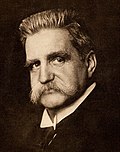Swedish Social Democratic Party
The Swedish Social Democratic Party (Swedish: [Sveriges socialdemokratiska arbetareparti] Error: {{Lang}}: text has italic markup (help)) was established on 23 April 1889, and is Sweden's biggest political party of social democracy. The party has been in the lead with a Prime Minister for the longest and most amount of time in Sweden. Stefan Löfven is the current leader for the party. The party lost to the Moderate Party in the 2006 and 2010 elections. However, in 2014 The Swedish Social Democratic Party won with 31% of the votes.
Sveriges socialdemokratiska arbetareparti | |
|---|---|
 | |
| Leader | Magdalena Andersson |
| Parliamentary group leader | Lena Hallengren |
| Headquarters | Sveavägen 68, Stockholm |
| Student wing | Social Democratic Students of Sweden |
| Youth wing | Swedish Social Democratic Youth League |
| Women's wing | Social Democratic Women in Sweden |
| Religious wing | Religious Social Democrats of Sweden |
| LGBT wing | LGBT Social Democrats of Sweden |
| Membership (2020) | |
| Ideology | |
| Political position | Centre-left[3] |
| European affiliation | Party of European Socialists |
| International affiliation | Progressive Alliance[4] |
| European Parliament group | Progressive Alliance of Socialists and Democrats |
| Nordic affiliation | SAMAK The Social Democratic Group |
| Colours | Red |
| Riksdag | 107 / 349 |
| European Parliament | 5 / 21 |
| County councils[5] | 572 / 1,597 |
| Municipal councils[6] | 4,364 / 12,780 |
| Website | |
| socialdemokraterna | |
Olof Palme, one of Sweden's most famous politicians, was the party leader from October many years before he was murdered in February 1986.
Years in power
- Cabinet Branting I, 1920,
- Cabinet Branting II, 1921-1923,
- Cabinet Branting III, 1924-1925,
- Cabinet Sandler, 1925-1926,
- Cabinet Hansson I, 1932-1936,
- Cabinet Hansson II, 1936-1940,
- SamlingsCabinet (Cabinet Hansson III), 1940-1945,
- Cabinet Hansson IV, 1945-1946,
- Cabinet Erlander I, 1946-1951,
- Cabinet Erlander II, 1951-1957 (With Bondeförbundet),
- Cabinet Erlander III, 1957-1969,
- Cabinet Palme I, 1969-1976,
- Cabinet Palme II, 1982-1986,
- Cabinet Carlsson I, 1986-1990,
- Cabinet Carlsson II, 1990-1991,
- Cabinet Carlsson III, 1994-1996,
- Cabinet Persson, 1996-2006,
Election results
|
|
Swedish Social Democratic Party Media
Hjalmar Branting, the first elected SAP Prime Minister in 1920
Prime Minister Tage Erlander at a TV debate in 1967
Social Democratic leader and Prime Minister Olof Palme in the 1970s
Göran Persson, a prolific Social Democratic leader, holding the office of Prime Minister for ten years
References
- ↑ (in sv) 15 000 medlemmar lämnade Socialdemokraterna. 29 January 2021. https://sverigesradio.se/artikel/15-000-medlemmar-lamnade-socialdemokraterna. Retrieved 24 May 2021.
- ↑ "Stadgar för Sveriges Socialdemokratiska Arbetarerparti" [Statutes for Sweden's Social Democratic Workers' Party] (in svenska). 3 November 2021. Retrieved 29 January 2023.
- ↑ Lane, Jan-Erik; Ersson, Svante (25 July 2008). "The Nordic Countries: Compromise and Corporatism in the Welfare State". In Colomer, Josep M. (ed.). Comparative European Politics (3rd ed.). Routledge. p. 261. ISBN 978-1-134-07354-2.
- ↑ "Parties & Organisations". Progressive Alliance. Archived from the original on 6 March 2017. Retrieved 22 July 2019.
- ↑ "2014: Val till landstingsfullmäktige – Valda" Archived 6 October 2014 at the Wayback Machine. Valmyndigheten (in Swedish). 28 September 2014. Retrieved 28 September 2014.
- ↑ "2014: Val till kommunfullmäktige – Valda" Archived 6 October 2014 at the Wayback Machine. Valmyndigheten (in Swedish). 26 September 2014. Retrieved 26 September 2014.
Other websites
| Wikimedia Commons has media related to Lua error in Module:Commons_link at line 62: attempt to index field 'wikibase' (a nil value).. |
- Socialdemokraterna Archived 2013-05-20 at the Wayback Machine (in English)




